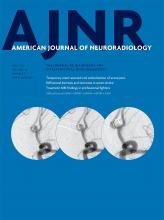Index by author
Manchikanti, L.
- You have accessThe Qualified Clinical Data Registry: A Pathway to Success within MACRAM.M. Chen, A.B. Rosenkrantz, G.N. Nicola, E. Silva, G. McGinty, L. Manchikanti and J.A. HirschAmerican Journal of Neuroradiology July 2017, 38 (7) 1292-1296; DOI: https://doi.org/10.3174/ajnr.A5220
Martola, J.
- Adult BrainOpen AccessRetention of Gadolinium-Based Contrast Agents in Multiple Sclerosis: Retrospective Analysis of an 18-Year Longitudinal StudyY. Forslin, S. Shams, F. Hashim, P. Aspelin, G. Bergendal, J. Martola, S. Fredrikson, M. Kristoffersen-Wiberg and T. GranbergAmerican Journal of Neuroradiology July 2017, 38 (7) 1311-1316; DOI: https://doi.org/10.3174/ajnr.A5211
Massand, M.G.
- FELLOWS' JOURNAL CLUBAdult BrainYou have accessPrevalence of Traumatic Findings on Routine MRI in a Large Cohort of Professional FightersJ.K. Lee, J. Wu, S. Banks, C. Bernick, M.G. Massand, M.T. Modic, P. Ruggieri and S.E. JonesAmerican Journal of Neuroradiology July 2017, 38 (7) 1303-1310; DOI: https://doi.org/10.3174/ajnr.A5175
Conventional 3T MR imaging was used to assess 499 fighters (boxers, mixed martial artists, and martial artists) and 62 controls for nonspecific WM changes, cerebral microhemorrhage, cavum septum pellucidum, and cavum vergae. Fighters had an increased prevalence of cerebral microhemorrhage (4.2% versus 0% for controls), cavum septum pellucidum (53.1% versus 17.7% for controls), and cavum vergae (14.4% versus 0% for controls). This study assessed MR imaging findings in a large cohort demonstrating a significantly increased prevalence of cavum septum pellucidum among fighters. Although cerebral microhemorrhages were higher in fighters than in controls, this finding was not statistically significant.
Mattle, H.P.
- NeurointerventionYou have accessImpact of Anesthesia on the Outcome of Acute Ischemic Stroke after Endovascular Treatment with the Solitaire Stent RetrieverA. Slezak, R. Kurmann, L. Oppliger, A. Broeg-Morvay, J. Gralla, G. Schroth, H.P. Mattle, M. Arnold, U. Fischer, S. Jung, R. Greif, F. Neff, P. Mordasini and M.-L. MonoAmerican Journal of Neuroradiology July 2017, 38 (7) 1362-1367; DOI: https://doi.org/10.3174/ajnr.A5183
Mcginty, G.
- You have accessThe Qualified Clinical Data Registry: A Pathway to Success within MACRAM.M. Chen, A.B. Rosenkrantz, G.N. Nicola, E. Silva, G. McGinty, L. Manchikanti and J.A. HirschAmerican Journal of Neuroradiology July 2017, 38 (7) 1292-1296; DOI: https://doi.org/10.3174/ajnr.A5220
Menjot De Champfleur, N.
- FELLOWS' JOURNAL CLUBExtracranial VascularYou have accessTIPIC Syndrome: Beyond the Myth of Carotidynia, a New Distinct Unclassified EntityA. Lecler, M. Obadia, J. Savatovsky, H. Picard, F. Charbonneau, N. Menjot de Champfleur, O. Naggara, B. Carsin, M. Amor-Sahli, J.P. Cottier, J. Bensoussan, E. Auffray-Calvier, A. Varoquaux, S. De Gaalon, C. Calazel, N. Nasr, G. Volle, D.C. Jianu, O. Gout, F. Bonneville and J.C. SadikAmerican Journal of Neuroradiology July 2017, 38 (7) 1391-1398; DOI: https://doi.org/10.3174/ajnr.A5214
This study included 47 patients from 10 centers presenting between January 2009 through April 2016with acute neck pain or tenderness and at least 1 cervical image showing unclassified carotid abnormalities. The authors conducted a systematic, retrospective study of their medical charts and diagnostic and follow-up imaging. All patients presented with acute neck pain, and 8 presented with transient neurologic symptoms. Imaging showed an eccentric pericarotidian infiltration in all patients. An intimal soft plaque was noted in 16 patients, and a mild luminal narrowing was noted in 16 patients. The authors conclude that this study improves the description of an unclassified, clinico-radiologic entity, which could be described by the proposed acronym: Transient Perivascular Inflammation of the Carotid artery (TIPIC) syndrome.
Miskin, N.P.
- SPINEYou have accessLumbar Puncture Test in Normal Pressure Hydrocephalus: Does the Volume of CSF Removed Affect the Response to Tap?S.K. Thakur, Y. Serulle, N.P. Miskin, H. Rusinek, J. Golomb and A.E. GeorgeAmerican Journal of Neuroradiology July 2017, 38 (7) 1456-1460; DOI: https://doi.org/10.3174/ajnr.A5187
Misra, U.K
- Adult BrainYou have accessPontomesencephalic Atrophy and Postural Instability in Wilson DiseaseJ. Kalita, S. Naik, S.K. Bhoi, U.K Misra, A. Ranjan and S. KumarAmerican Journal of Neuroradiology July 2017, 38 (7) 1343-1347; DOI: https://doi.org/10.3174/ajnr.A5207
Mitsouras, D.
- Open Access3D-Printed Patient-Specific Models for CT- and MRI-Guided Procedure PlanningE. George, P. Liacouras, T.C. Lee and D. MitsourasAmerican Journal of Neuroradiology July 2017, 38 (7) E46-E47; DOI: https://doi.org/10.3174/ajnr.A5189
Modic, M.T.
- FELLOWS' JOURNAL CLUBAdult BrainYou have accessPrevalence of Traumatic Findings on Routine MRI in a Large Cohort of Professional FightersJ.K. Lee, J. Wu, S. Banks, C. Bernick, M.G. Massand, M.T. Modic, P. Ruggieri and S.E. JonesAmerican Journal of Neuroradiology July 2017, 38 (7) 1303-1310; DOI: https://doi.org/10.3174/ajnr.A5175
Conventional 3T MR imaging was used to assess 499 fighters (boxers, mixed martial artists, and martial artists) and 62 controls for nonspecific WM changes, cerebral microhemorrhage, cavum septum pellucidum, and cavum vergae. Fighters had an increased prevalence of cerebral microhemorrhage (4.2% versus 0% for controls), cavum septum pellucidum (53.1% versus 17.7% for controls), and cavum vergae (14.4% versus 0% for controls). This study assessed MR imaging findings in a large cohort demonstrating a significantly increased prevalence of cavum septum pellucidum among fighters. Although cerebral microhemorrhages were higher in fighters than in controls, this finding was not statistically significant.








